Sound Meters
Digital sound level meters for measuring levels of noise and noise pollution in commercial, domestic and industrial areas. Also includes sound level monitors for continuous monitoring of sound levels with audible indication when limits are exceeded.
Find out more about Sound Meters below.
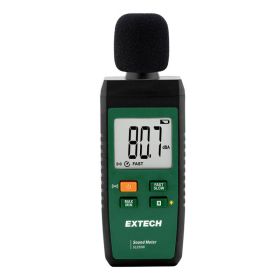
- 30 to 130dB with ‘A’ weighted frequency for human hearing
- Data Hold, Min/Max Recording, & Auto Power Off
- Compatible with Extech’s free ExView App
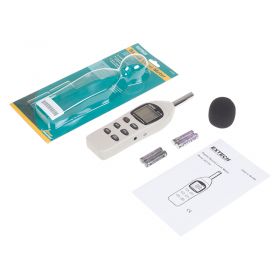
- Analogue bargraph and 2000-count LCD display
- Lightweight, auto-off and slow/fast response time
- Records min/max values using electret condenser microphone
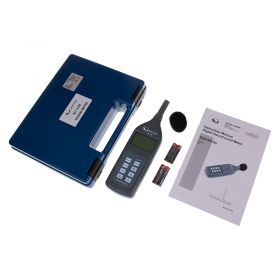
- Measure noise intensity within workplaces
- Differentiate between normal noise influences and excessive noise influences
- Internal memory with the capacity to store up to thirty measurements
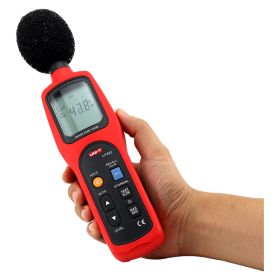
- Capable of measuring up to 130 decibels and frequencies of 8,000 Hertz
- A range of features including a hold function and a MIN/MAX function
- Capable of storing over 60 pieces of data
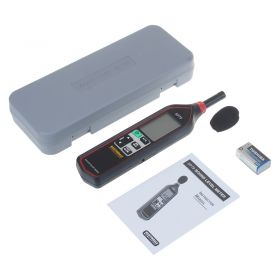
- Measure sound levels from 32 to 130dB
- Selectable A and C frequency weighting
- In compliance with Class 2 regulations - BS EN 61672-1
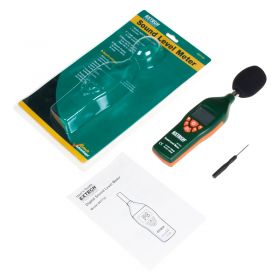
- High accuracy meets ANSI and IEC 651 Type 2 standards
- High and Low measuring ranges: 35 to 100dB (low) and 65 to 130dB (high)
- Data Hold and Max Hold functions
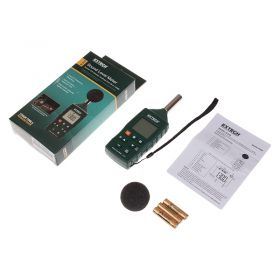
- ‘A’ &‘C’ Frequency Weighting
- Backlit display
- ±1dB high accuracy
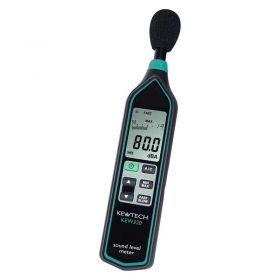
- Optimised for electrical contractors
- 32dB to 130dB measurement range split into three levels spanning 60dB
- A/C frequency weighting and FAST/ SLOW time weighting
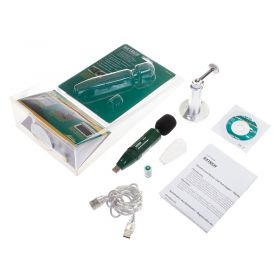
- Cost-effective solution for logging sound levels over a period of time
- Configure and download using USB connection to PC
- Fully configurable measurement rate - choose 50ms, 500ms, 1s, 2s, 5s, 10s or every minute
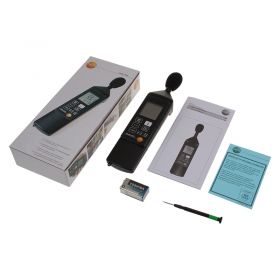
- Reliable, accurate measurements of sound
- Adjustable frequency weighting and measurement speed
- Wind cap included for use in outdoor/demanding conditions
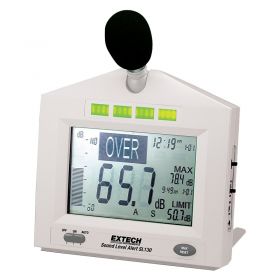
- Built-in desk, wall, and tripod mounts
- Bright LEDs can be read from 100ft (30m)
- Continuous monitoring of sound level in 3 ranges
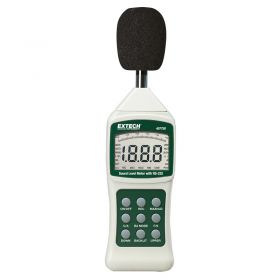
- Interface with a PC for analysis of test results
- Electret microphone provided
- LCD screen with refresh readings every half a second
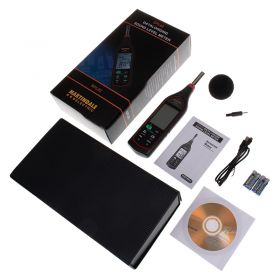
- Class 2 sound meter for maintaining compliance with noise and work legislation
- Ideal for use in offices and industrial environments
- Can log up to 64 000 readings
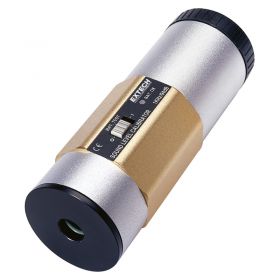
- Calibrates and verifies operation
- Durable die-cast, aluminium housing
- 1kHz sine wave at 94dB
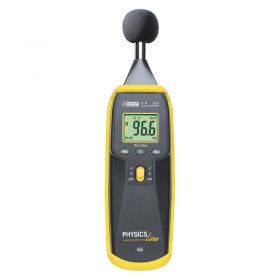
- Tests decibel levels up to 130dB
- Features a useful memorization function
- Compact enough to take on the job
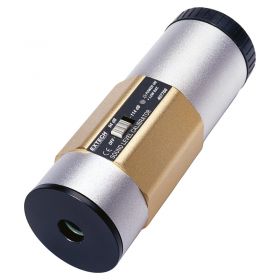
- Calibrates and verifies operation
- Durable die-cast, aluminium housing
- Level position to select 94dB or 114dB
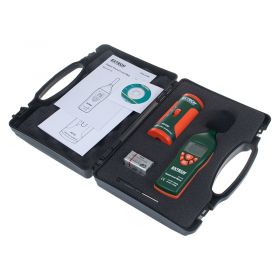
- High and Low measuring ranges: 35 to 100dB (low) and 65 to 130dB (high)
- Data Hold and Max Hold functions
- Includes 407722 - 1kHz 94dB sound calibrator (±5% accuracy)
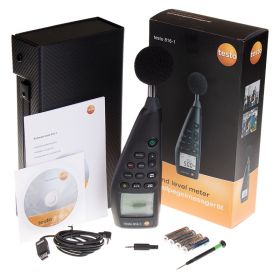
- Measurement range from 30 to 130dB
- A and C frequency weighting
- Built in 31000 record memory
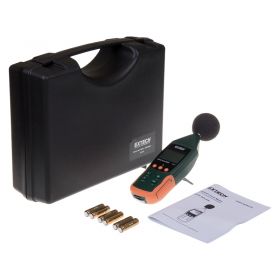
- Comes with a case, six AA batteries, SD card, carrying case and a wind screen
- Can store up to 20M readings with a 2GB SD memory card
- Built-in PC interface means it’s really to transfer data to a computer

- Perform sound surveys over a period of time
- Datalogs up to 999,999 records
- Clips onto clothing
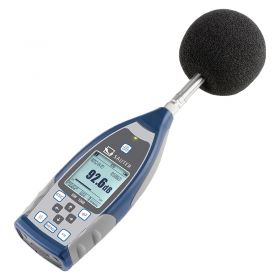
- Comprehensive Class I and Class II sound meters
- Ideal for measuring noise intensity in busy, outdoor environments
- Data logging and data transfer capabilities
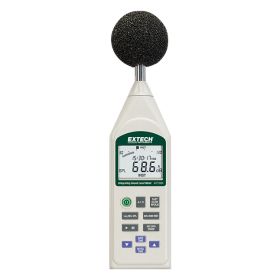
- 4-digit multifunction LCD
- Built-in datalogger
- A and C frequency weighting options
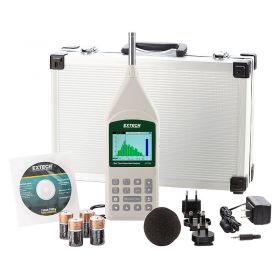
- Powerful sound meter with integrated octave band analyser
- High quality, full colour backlit TFT screen
- A, C and Z frequency weighting
About Sound Meters
Used mainly for measuring sound in industrial and environmental areas and for quantifying sound levels on aircraft, a sound level meter is an essential tool for professionals working in areas where measuring sound accurately is a high priority.
A sound level meter from Tester will allow you to measure various amounts of sound within your workspace, ensuring that it is at a safe operating level for human ears. In noisy environments, not protecting employees' ears can lead to noise-induced deafness, so it is important to evaluate the sound levels within your workspace if you're working with loud machinery, devices, or vehicles.
When measuring the levels of noise in an area, regulations state that the level of LEP,d (worker's daily exposure to noise) must conform to certain standards as dictated by the Physical Agents Noise Directive; an EU directive that came into effect in April 2006. These are:
- Lower action level (LEP,d 80dB(A)) - Individual hearing protectors should be made available, and training and information on the risk of hearing damage must be given to workers.
- Upper action level (LEP,d 85dB(A)) - Noise must be reduced where it can be. All employees must have hearing protectors and make sure they wear them. Again, training and information must be provided on correctly using hearing protectors.
- Exposure limit (LEP,d 87dB(A)) - Under no circumstances should the exposure of the worker exceed these limits as it can be extremely dangerous.
By using a sound meter you can accurately measure the daily exposure a worker may be exposed to and then take relevant steps to ensure their hearing doesn't suffer lasting damage.
Sound Meter Types (Classes)
Sound level meters are not placed into one collective group - depending upon applicable standards they are defined as what's known as sound meter classes, or sound meter types. The most generally accepted definition of a sound meter comes from IEC regulations, which define that sound meters are placed in two different classes.
Known as class 1 and class 2 sound meters, this standard defines the difference between the two in the meters' overall tolerance for error. Class 1 meters generally ship with a wider frequency range and tighter tolerance, whereas class 2 meters are defined by the fact that they have a lower frequency wider, and lesser tolerance. This means that Class 1 sound level meters are much more accurate and therefore are much more acceptable for use in noise surveys, particularly where measurement accuracy is of the utmost importance.
In addition to classes, the ruling IEC 61672-1 inserts sound meters into "three kinds of sound measuring instruments". These are defined as a conventional sound level meter, an integrated-averaging sound level meter, and an integrating sound level meter.
Certain types of sound meters - which are governed by IEC 61252: 1993 - are known as noise dosimeters (noise dosemeters in Britain). These meters are designed to integrate directly with a person to determine the noise exposure of that person over time and are commonly used to comply with regulations such as Occupational Safety and Health (OSHA) 29 CFR 1910.95 Occupational Noise Exposure Standard or EU Directive 2003/10/EC.
Accepted Sound Meter Standards
To be classified as acceptable for use a sound meter generally must adhere to the standard IEC 61672 (or British standard equivalent BS EN 61672) to gain certifiable status as a Class 1 or Class 2 sound level meter. Depending on the type of meter being used this standard may or may not be applicable in conjunction with other standards, and there are several other standards available for things such as noise dosimeters, personal sound exposure meters, and various other devices. Sound calibrators are also governed by their standards.
The following is a list of the currently accepted sound meter standards available around the world:
IEC 61672 - Electroacoustics - Sound Level Meters
The most commonly used standard, IEC 61672 is used as a quantifying tool for defining whether a modern sound meter is given class 1 or class 2 status. The status is given depending on the tolerance and overall frequency range of the sound meter; class 1 meters have a much higher tolerance than class 2 do, making them a much more accurate tool for quantifying overall sound levels.


